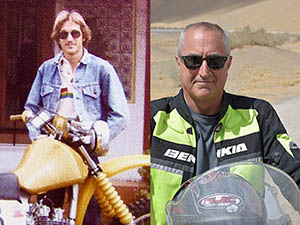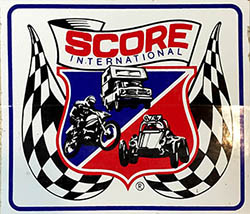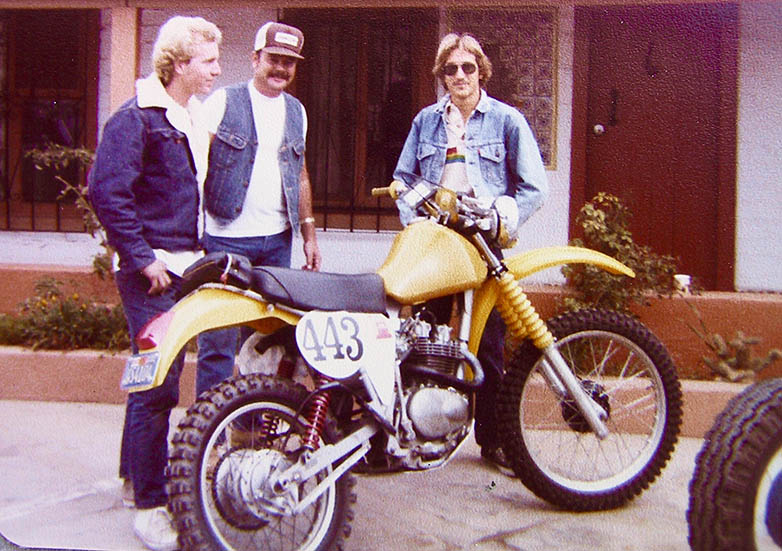
There comes a moment in every man’s life when he will be required to delve deep into the reservoir of his character and choose if he is a hero, or a goat. My opportunity occurred at 1:30 AM on a cool November back in 1979. Body sprawled upon the unforgiving Baja soil, mouth full of dust and knuckles swollen from spiny cactus punctures, the abyss of my soul required sounding.
Enlightenment was not my original goal in entering the Baja 1000 desert race. After several years of a truncated, 1000-kilometer Ensenada-to-Ensenada Baja Lite version, the legendary race was restored to its original full-strength, 1000 statute-mile distance in 1979. Ensenada-to-La Paz was the race I’d dreamed about riding since I was a child. Being twenty-two years old and having never entered a motorcycle competition at any level did nothing to shake my confidence. Unlike the seasoned pros, I had a plan.
 The plan was genius: In 1979 there were only five entrants in the 250cc class. With a historical attrition rate of at least 50%, the Baja desert would do the dirty work. All we had to do was stay together and keep moving. A podium finish was assured. SCORE, the event organizers, made it even easier by allowing a maximum of 41 hours to complete the course. Hell, a 25 mile-per-hour average would do the trick.
The plan was genius: In 1979 there were only five entrants in the 250cc class. With a historical attrition rate of at least 50%, the Baja desert would do the dirty work. All we had to do was stay together and keep moving. A podium finish was assured. SCORE, the event organizers, made it even easier by allowing a maximum of 41 hours to complete the course. Hell, a 25 mile-per-hour average would do the trick.
The motorcycle question was solved when a used C&J Honda frame was found. The C&J was a chromemoly assembly that was half the weight of Honda’s construct. Rear suspension was long-travel controlled by two Curnett shock absorbers. Front suspension was from an unknown Yamaha. Topped with a 3-gallon plastic fuel tank, the bike looked every bit the $475 paid.
Peebles Thunder Machines of Point Loma, California provided an endurance-prepped 1973 Honda XL 250cc single cylinder, four-valve engine. P.T.M. removed several thousandths of an inch off the top and valve pockets of a forged Venolia piston, the idea being to lower the compression of the engine enough to use the notoriously low-octane Mexican gasoline. The intake ports were cleaned up, while the exhaust ports received a violent going over. Peebles Jr. spent several days hogging out aluminum to the point of cutting down and faring in the valve guides.
Heavy clutch springs and new plates completed the otherwise stock engine. The bike topped out at 70 miles per hour and could run on donkey urine. Peebles Sr. encouraged me to run the bike flat out all the time. “You cannot blow this engine.”
Between the bike needing assembly and testing, our team having full time jobs, and beer not being capable of consuming itself, the days passed without any actual off road practice by either me or my co-rider Len. We were philosophic about training and agreed that the 1000 miles made available during the race would be plenty of time to get the hang of it.
Our team joined one of the pit crew troupes formed specifically to assist desert racers. The Magnificent Seven provided several pit stops along the course. Welding machines, generators, air compressors, water, food, and any gasoline or spare parts you gave them would be delivered to the stops. We had various sized cans of high-test and one rear wheel shod with a used trials tire dispersed throughout the 1000 miles of brutal desert terrain.

Final preparations were made only hours before we left for Mexico. The bike needed a chain and I had to borrow leathers. With no time to stop and reflect on what we were attempting, Team Leader Greg, Lenny, several cases of beer, the C&J and I made for our Ensenada motel.
Part II to follow soon…


